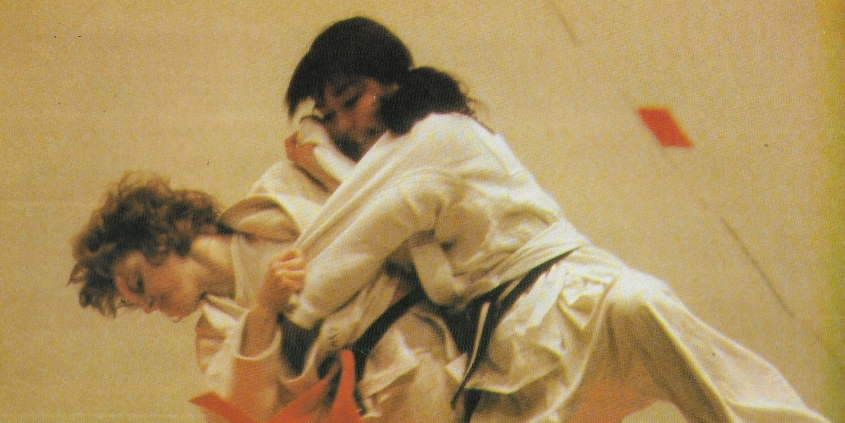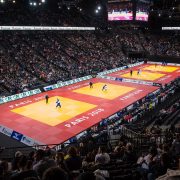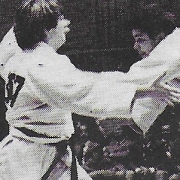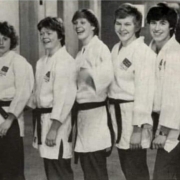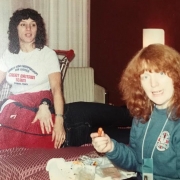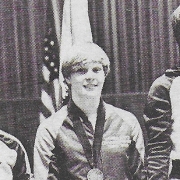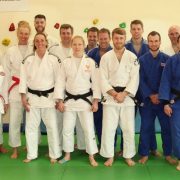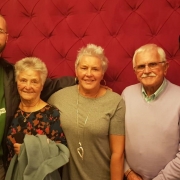First Women’s World Championships #7 – Catching Up with Jane Bridge
Jane Bridge -48 Kg was the last of the GB Team to fight for a medal on that second day. Together with the Open category running simultaneously in which Avril Malley was engaged, these were the last weight categories of the Championship.
Let us go straight to the result and re-express it the way that Jane feels is overlooked. Here goes: – Jane Bridge is the First British World Judo Champion. She had given the GB men a 24-year head start, but no British man at that time had won a World Championship. Jane, with her win that day, catapulted Women’s judo to the forefront in Great Britain – she was the first GB Judoka to come through a World Class competition and be able to say, “no one beat me, I am champion of the world”. Not that she would, she was too modest, but she was able to do so if she wanted, and how the World admired her for her very British humble demeanour in what she had achieved.
In making this statement, this is not in any way derogatory towards the male GB Team at that time. Indeed, the Judoka I most admired and still do for his judo excellence and skill is to my mind Neil Adams. My Dad was Great Britain’s number one Judo fan and could have been a TV pundit on the sport if such a position existed and he maintains that in his day, there was no one could touch Neil Adams for his beautiful, technically sophisticated Judo and ability to wipe the floor with the competition, and be a pleasure to watch and admire. Earlier in 1980, Neil got Silver at the Olympic Games, and only a momentary lapse in his concentration in that competition robbed him of the Gold that the whole world justifiably (in my opinion) expected him to achieve.
When chatting with Jane, she was also a huge admirer of Neil. She remembered watching Neil in his final in 1980 and like all of us, was so disappointed for him with his loss. Some 9 months later, Neil brilliantly won the Men’s World Championship Gold in Maastricht in September 1981.
Between Neil and Jane, British Judo was the admiration of the world.
Lets us now look at how Jane battled her way through to this achievement on the day.
Jane was 20 years old, three times European Women’s Champion in 1976, 1978 and earlier that year in March 1980. Admittedly, she was favourite to win, but that did not make her route to Gold any easier, because the outlook from the draw was that she would inevitably have to overcome some hugely formidable opponents if she was to match the heavy expectations falling upon her slender shoulders.
And… she was potentially hugely disadvantaged that day … but the British Team were keeping the matter under close watch, and there again, they were not actively letting it be widely known, but Jane for the past month to six weeks had been suffering from Bell Palsy. The right side of her face was paralysed: she could not close her right eye fully: she was suffering from numbness in her limbs: and it was severe enough to require cortisone injections which had been properly declared and sanctioned under medical supervision of the necessary Judo Governing Bodies of the day.
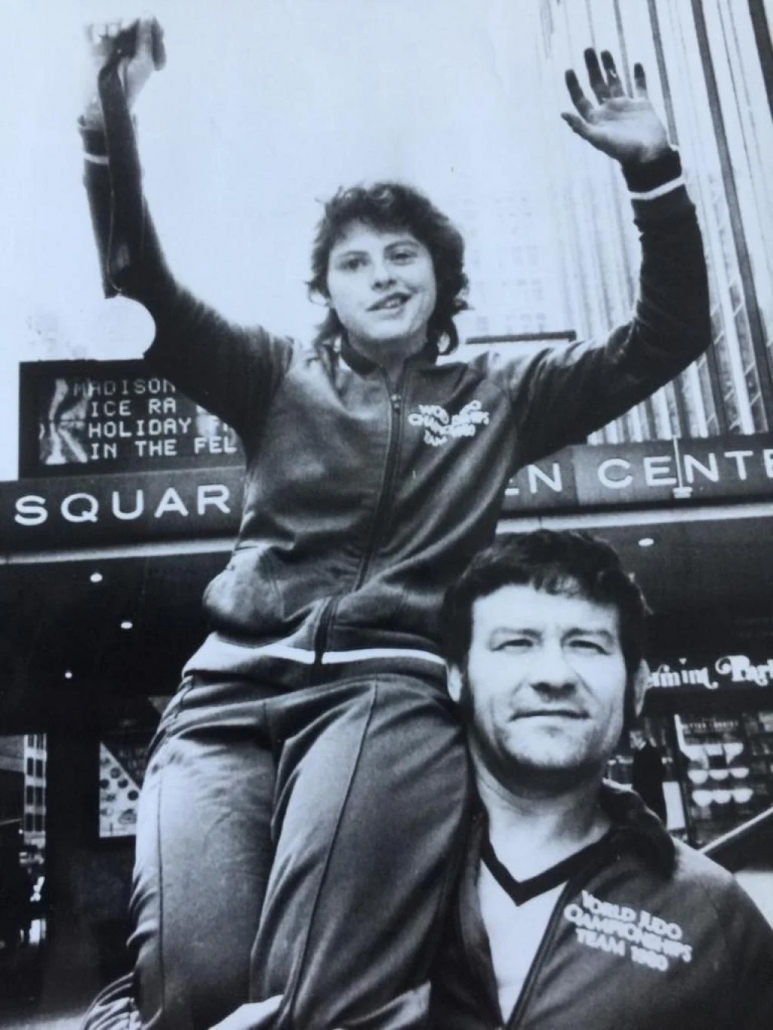
Photo: Jane Bridge on Coach Roy Inman’s shoulders after winning the First Women’s World Judo Championship in New York Madison Square Garden, her temporary Bell’s Palsy face paralysis is evident
Her first fight was against Betsabeth Hernandez of Venezuela, who was current Pan American Champion at that weight and part of a very credible Team that had been entered from Venezuela. Jane finished this match after 2 minutes 10 seconds, scoring two Yukos followed by an Ippon from Juji-gatame.
This led on to her fighting Marie-France Colignon of France, who was around the same age as Jane and had achieved Silver in earlier years French Championship and a Gold in Strasbourg. In my chat with Jane, she described Marie France Colgnon as her toughest opponent of the day. However, within 55 seconds of the bout, Jane caught Colignon with Seoi-Toshi and threw her for a Wazari thus progressing to the semi-final. Judo Magazine in their write-up of the bout later said that Colignon “was no-match” for Jane, but Jane thought otherwise: Colignon was a formidable opponent and Jane was very happy to have got through that round as she did.
If she won her next fight against Tina Takahashi, the four times Canadian Champion, she would be in the final. This was a pressure bout: the Canadian had earlier beaten her fancied Japanese namesake opponent and had shown an attractive range of techniques in coming through the competitions by also defeating Radmila Lejic (three times Silver medallist in her Yugoslavian Championships) and Maria Luisa Iglesias (Four times Spanish Champion).
By this time, all participants still surviving in this weight category had been through quite a number of fights to reach this stage, and it was perhaps here that Jane was able to show that she had more stamina and fight left in her. One of the resounding and admired features of Jane’s style of Judo was that she was highly technical: she was not a scrapper; she was not physical: she was just a master of the art and craft of Judo and most of her wins came from clever use of technique, excellently deployed from her wide armoury. In having this excellence, Jane seldom found herself in exhaustive Ne-Waza groundwork and the like. Her wins were often short and sharp affairs that did not physically drain her and kept her strong for later stages of competitions.
Tina Takahashi looked tired and proved no match for Jane and she was thrown around by Jane for several scores before Jane employed a strong left-handed grip that led into a superbly clean right-handed Seoi-Toshi for Ippon less than 3 minutes into this 5 minute semi-final.
Going into the final, it has got to be said that any fears that Roy Inman or the coaching team or the GB Women’s Team may have had about Jane’s Bell’s Palsy were rapidly evaporating. She looked unstoppable. Thus, the final head-to head for the First Women’s World Championship was between Jane Bridge and Anna de Novellis of Italy, twice her country’s National Champion, with Gold and Silver in other competitions.
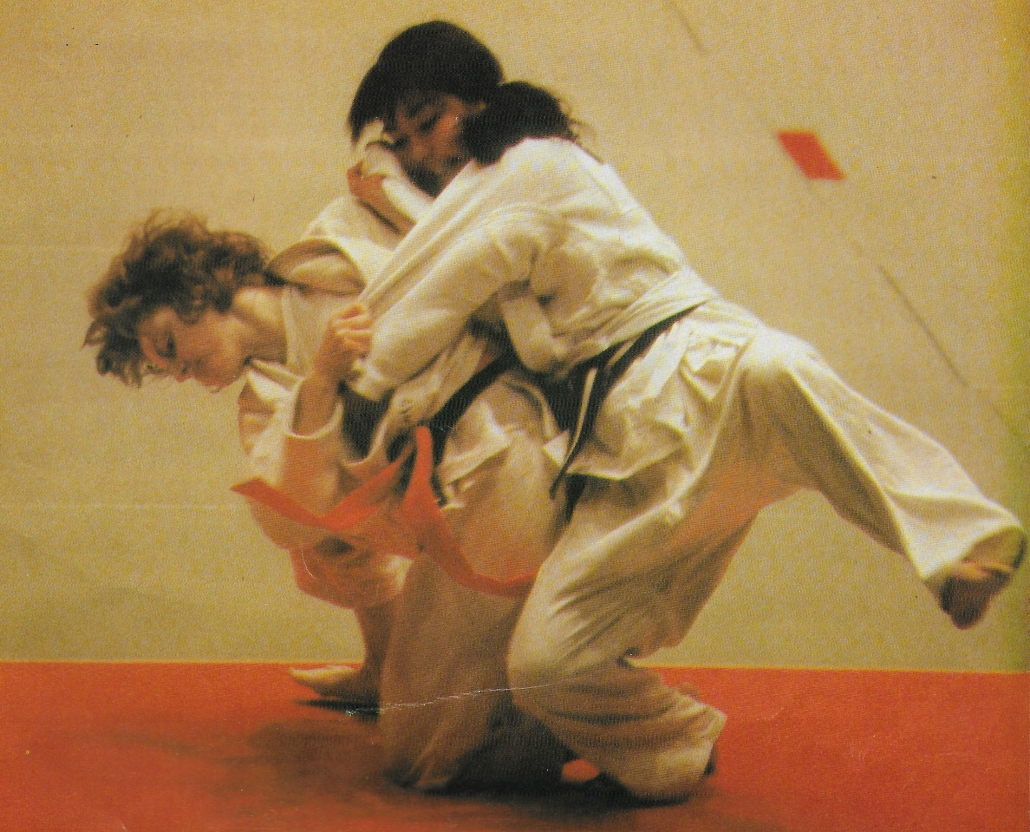
Photo: Jane in action against Tina Takahashi of Canada in the semi-final match
Jane won the final, as we know, but it was the manner of the win that reinforced the respect she commanded. She almost made it look like a training session, when at one stage, with strong lapel grips, she fell onto her back and almost pulled off a spectacular Sutemi-Waza attack . With this having failed, there was then no shortage of scoring Kokas, Yukos and Wazari from different throws to finish it off with another Wazari from Yoko-Shiho-Gatame.
This was not just winning judo, Jane had put on a demonstration bout, that the huge Madison Square crowd lapped up, and for once the noise created by the supporting GB contingent was drowned out by the roar of admiration and applause from the appreciative audience from across the Globe.
It is no surprise that when it came time for the medal award ceremony, not only did Jane receive her Championship Gold Medal, but she won a special award presented by the Japanese Embassy for the “Technically Best” player of the Tournament, which was in the form of a beautiful Silver Apple (from Tiffany’s New York, no less) and a diamond necklace from Sasson Jeans.
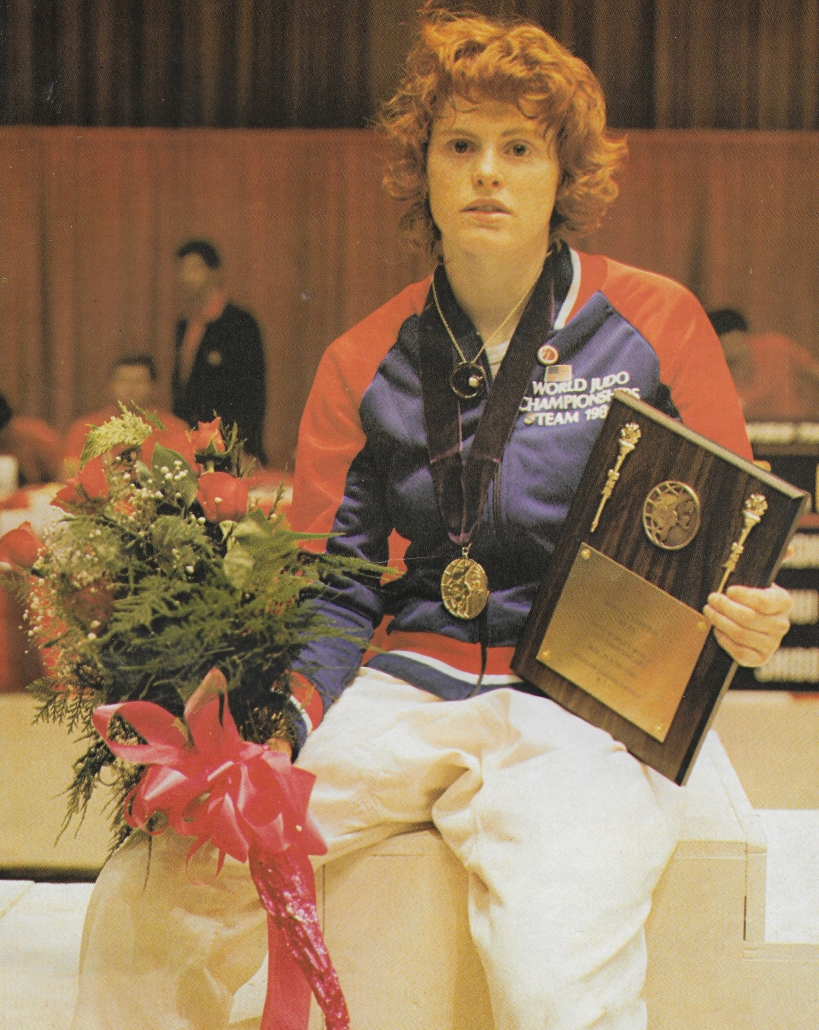
Photo: Jane with Gold medal and awards at the First Women’s World Championship 1980
What does Jane remember about the First Women’s World Championships and its impact on her life and Woman’s Judo?
On being asked this question, Jane paused for a long period before answering:
“… Do you know, Loretta, I struggle to answer that one because for me the whole thing was just so terrifying. The weight of expectation on me going into this final was massive. I had the background worry about the Bell’s Palsy that was hitting my nervous system and creating fatigue. I remember being scared, and very emotional. At one stage before the competition commenced, and this is a very powerful memory to this day, I went into my hotel bedroom by myself, and I just cried, and cried and cried… … and that was the best thing I could have done … it’s what women tend to do that differentiates us from men … and do you know, I just felt just SO much better after that and ready to get into battle and get it over and done with…”
“… and I remember Ann Hughes… we were really close…. she was my training partner… and when she lost I just felt sad … the whole team did … she deserved to get a medal and was so unlucky on the day. It just didn’t seem fair …”
“… and I remember my Mum & Dad came all the way to see me in New York … and in the middle of concentration during one of the fights … I became aware that I recognised my Mum’s voice shouting encouragement from the spectators area, and I had to ignore it and focus on what I was doing … but it was good to hear her and know she was there when I was just so nervous and under stress …”
And for Jane, it was many years later that she was able to appreciate the true consequence and impact on her life. If anything, her Judo initially made life difficult for her – financially she struggled to find employers that were willing to give her time off for tournaments, long weekends away, and they were not necessarily impressed with her Judo titles. There was no funding available to enable her to go full-time – all she got was £10 per month from the Government Sports Aid Foundation. But gradually, Judo opened up doors and opportunities for her from the unusual (5 foot 2 inches tall and working as Sylvester Stallone’s bodyguard) to the present day (Vice-President of the European Judo Federation with responsibility for Education).
Jane Bridge -48Kg – where is she now?
Jane started her Judo journey at age 10 in her hometown of Bolton at the Otanikwai Club. Her parents introduced her to Judo. Their own active involvement on the mat was fairly short-lived but they retained an active interest in the theory through books and magazines, and in this way most probably continuously contributed to the technical excellence which is an integral part of Jane’s game-play for which she is renowned and admired. The eldest child in the family, she had three younger brothers who have all spent time on a judo mat and moved on but were good training buddies for Jane throughout her early life and teen years. Nowadays, it is hard to describe where she lives. Yes, her home is in Hungary where she lives with her fiancé, but her routine frequently takes her to Paris to visit her son, and home to England to visit her mother, and trips to South Africa which is her fiance’s home country. In an article on the EJU website an indication of her jet-setting lifestyle is given when she said, “… some of my main rivals have become good friends and I can easily pop over to Stockholm to see my ex rival and now great friend Ann Lof and drink a beer and talk about judo until late hours in the evening…”
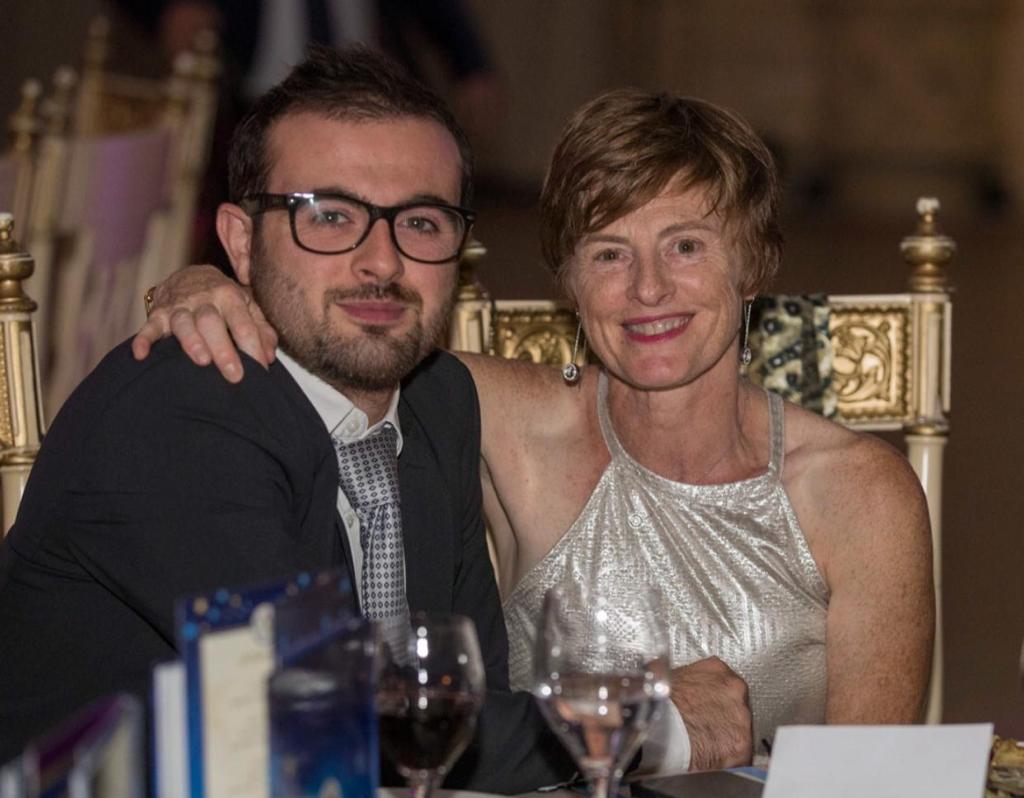
Photo: Jane with her son Joseph who lives in Paris
When I spoke to Jane she had just arrived back into Paris where she was on the mat leading a seminar for 60 coaches from around Europe, mostly men she said (she would like to see more women at this level and strives to achieve this). She made the point just that the fact that she was a women in front of 60 coaches is indicative of the way things can be, triggered by developments like the First Women’s World Championships 40 years ago, but it should never stop and that is why she is so well suited to her current role with the EJU. In 2016, Jane began working with the European Judo Union and she has progressed to now be the Vice President for Education, where it is her passion to develop judo within Europe by such things as expanding the adoption of Judo in Schools as part of the normal curriculum and also the development of coach education.
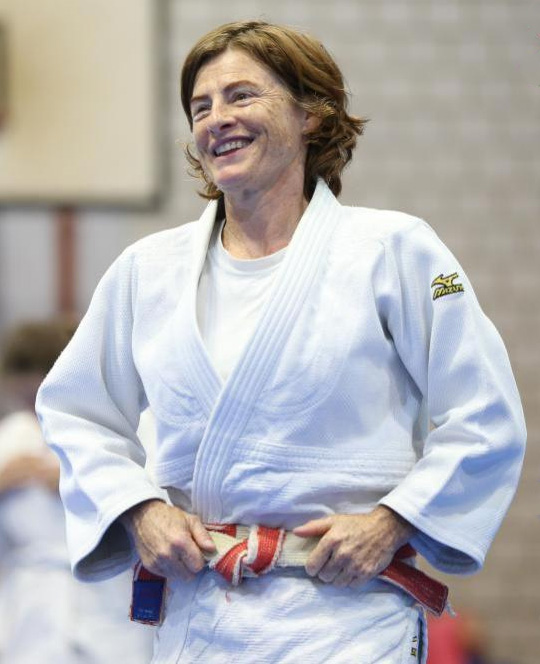
Photo: Jane on the mat in her role of EJU Educator
All this good work ranging from being a pioneer of women’s judo to this present day was commended by being inducted in to the IJF Hall of Fame in 2018 during the Baku World Championships. Jane is an 8th Dan.

Photo: inducted in to the IJF Hall of Fame in 2018 during the Baku World Championships
This is the final chat with members of the GB Competitive Team. Following this article will be a focus on my chats with the Coaching and support heroes of 40 years ago, without which the Team’s success would not have been possible.
It is appropriate to end these chats on a high with Jane having achieved so much in our world of Judo and for which she is a role model, not only to me both in those days and today but has inspired many to great things. In her footsteps, for example, she was immediately followed by Karen Briggs, four times World Champion in the same -48 Kg weight category.

